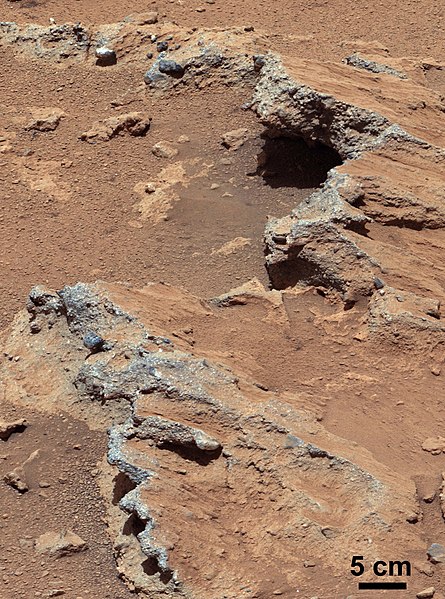English: PIA17062: Remnants of Ancient Streambed on Mars (White-Balanced View)
http://photojournal.jpl.nasa.gov/catalog/PIA17062
NASA's Curiosity rover found evidence for an ancient, flowing stream on Mars at a few sites, including the rock outcrop pictured here, which the science team has named "Hottah" after Hottah Lake in Canada's Northwest Territories. It may look like a broken sidewalk, but this geological feature on Mars is actually exposed bedrock made up of smaller fragments cemented together, or what geologists call a sedimentary conglomerate. Scientists theorize that the bedrock was disrupted in the past, giving it the titled angle, most likely via impacts from meteorites.
NASA's Mars Science Laboratory (MSL) Curiosity rover found evidence for ancient, water-transported sediment on Mars at a few sites, including the rock outcrop pictured here, named "Hottah." Rounded pebbles within this sedimentary conglomerate indicate sustained abrasion of rock fragments within water flows that crossed Gale Crater.
The key evidence for the ancient stream comes from the size and rounded shape of the gravel in and around the bedrock. Hottah has pieces of gravel embedded in it, called clasts, up to a couple inches (few centimeters) in size and located within a matrix of sand-sized material. Some of the clasts are round in shape, leading the science team to conclude they were transported by a vigorous flow of water. The grains are too large to have been moved by wind. Erosion of the outcrop results in gravel clasts that protrude from the outcrop and ultimately fall onto the ground, creating the gravel pile in the left foreground. The scale bar at lower right is 5 centimeters (2 inches).
This view of Hottah is a mosaic of images taken by the right (telephoto-lens) camera of the Mast Camera instrument (Mastcam) on Curiosity during the 39th Martian day, or sol, of the rover's work on Mars (Sept. 14, 2012 PDT/Sept. 15 GMT). It has been enhanced for presentation in white-balanced color, which yields a view as if the rock were seen under outdoor lighting conditions on Earth, which is useful for scientists to distinguish rocks by color in familiar lighting. A "raw color" view of Hottah, showing the colors as recorded by the camera on Mars, is at PIA16156. A stereo view is at PIA16223.
Malin Space Science Systems, San Diego, built and operates Mastcam. NASA's Jet Propulsion Laboratory manages the Mars Science Laboratory mission and the mission's Curiosity rover for NASA's Science Mission Directorate in Washington. The rover was designed, developed and assembled at JPL, a division of the California Institute of Technology in Pasadena.
For more about NASA's Curiosity mission, visit
http://www.jpl.nasa.gov/msl,
http://www.nasa.gov/mars, and
http://marsprogram.jpl.nasa.gov/msl.






